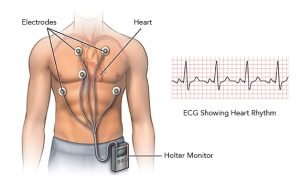Diagnostics
Holter Monitor
Holter Monitor Test: Tracking Heart Rhythm for Better Health.
What is Holter Monitor?
The Holter monitor is a compact, portable device that records the heart’s rhythm and detects or assesses the risk of irregular heartbeats (arrhythmias).
This Holter monitor is a portable electrocardiogram (ECG) device that continuously records the heart’s electrical activity for 24 hours outside the doctor’s clinic. It offers a comprehensive and continuous assessment of the heart’s electrical patterns, in contrast to a standard or “resting” ECG, which provides a quick evaluation of the heart.
During a standard ECG, electrodes (small plastic patches) are placed on specific locations of the chest and abdomen. These electrodes are connected to an ECG machine via wires. The machine measures, records, and prints the heart’s electrical activity without sending any electricity into the body.
On the other hand, the Holter monitor is worn by the patient throughout the day, allowing for an extended period of monitoring. It provides a more comprehensive analysis of the heart’s electrical patterns during daily activities, potentially capturing irregularities or abnormalities that may occur outside of the healthcare provider’s office.
Who conducts Holter Monitor testing?
Holter monitor testing is typically performed by healthcare professionals, such as medical technicians, nurses, or trained technicians who specialize in cardiology. These professionals are responsible for applying the Holter monitor device to the patient, ensuring it is properly connected, and providing instructions to the patient on wearing and caring for the device. After the monitoring period (usually 24 to 48 hours), the collected data is analyzed by cardiologists or other specialized medical personnel to assess the patient’s heart rhythm and diagnose any irregularities or cardiac issues.
Why is Holter monitoring done?
A doctor may recommend a Holter monitor if the patient has the following:
- Signs and symptoms of an irregular heartbeat (arrhythmia)
- The symptoms of dizziness, fainting, low blood pressure, ongoing tiredness, or palpitations
- Heart disease that increases the risk of arrhythmias
Before getting a Holter monitor, an electrocardiogram (ECG or EKG) is typically conducted. This painless test involves placing electrodes on the chest to assess the heart’s rhythm. However, if arrhythmias occur infrequently, a standard ECG may not detect them. In such cases, a Holter monitor is utilized to identify irregular heart rhythms. An event monitor may be recommended if a regular Holter monitor fails to capture an irregular heartbeat. This device records heartbeats over a longer period, often lasting several weeks. It enables monitoring and detecting any irregularities during this extended duration.
What are the risks of Holter monitors?
There are no significant concerns with the Holter monitor. Some individuals may experience mild discomfort or skin irritation at the site where the electrodes were placed.
Holter monitor signals are not usually affected by other electrical devices. However, avoiding certain items that may disrupt signal transmission is advisable. These include electric blankets, electric razors and toothbrushes, magnets, metal detectors, and microwave ovens. Additionally, it is recommended to keep cellphones and portable music players at least 6 inches away from the Holter monitor to prevent signal interference.
How should an Individual prepare for the Holter monitor?
Preparation before Holter monitor
The doctor will provide a detailed explanation of the procedure and address any questions that the patient may have. Fasting is not required. The doctor may request additional preparations depending on specific medical conditions.
During Holter monitor
During the Holter monitoring process, the following steps usually take place:
- Placement of electrodes: The technician will attach small adhesive electrodes to specific locations on the chest. These electrodes are connected to the Holter monitor device. The areas where the electrode patches are placed are cleaned, and in some cases, hair may be shaved or clipped so that the electrodes will stick closely to the skin.
- Holter monitor device: The monitor is a small, portable device that records the heart’s electrical activity. It is typically worn for 1-2 days as a belt around the waist or carried in a pocket or pouch. The electrodes are connected to the monitor via wires.
- Monitoring period: The patient will be instructed to go about their daily activities while wearing the Holter monitor. It is important to keep a diary, noting any symptoms or activities that may be relevant during the monitoring period.
- Maintaining the monitor: The patient will be given specific instructions on how to care for the Holter monitor and electrodes.
- Avoid bathing, showering, or swimming.
- Refrain from undergoing X-rays.
- Stay away from high-voltage areas, metal detectors, or large magnets.
The patient will return the Holter monitor to the healthcare facility at the end of the monitoring period. The recorded data will be analyzed by a doctor, usually a cardiologist, who will interpret the results.
References
- Mayo Clinic. Holter monitor. Accessed from https://www.mayoclinic.org/tests-procedures/holter-monitor/about/pac-20385039
- Holter monitor. Accessed from : https://www.heart.org/en/health-topics/heart-attack/diagnosing-a-heart-attack/holter-monitor. Updated on 2023 July.
- Holter monitor. Accessed from: https://www.hopkinsmedicine.org/health/treatment-tests-and-therapies/holter-monitor#:~:text=The%20Holter%20monitor%20is%20a,used%20to%20evaluate%20the%20heart.



